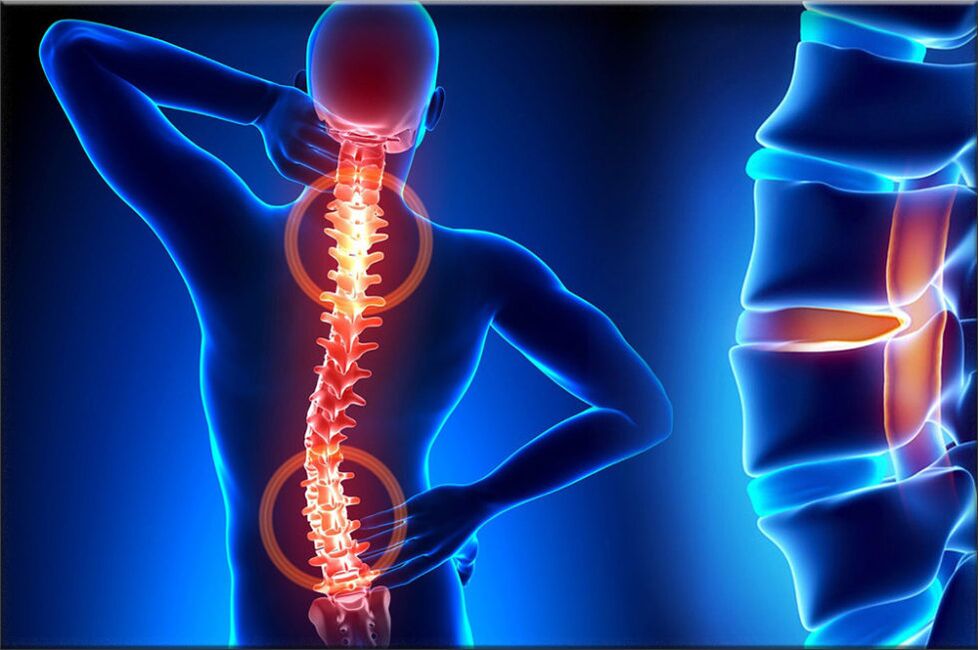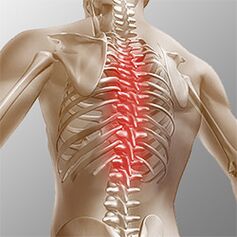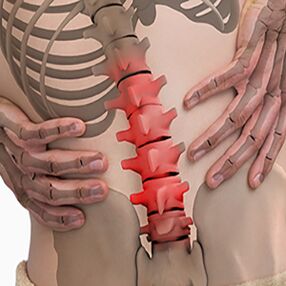
Osteochondrosis is one of the most common diseases of the musculoskeletal system, which manifests itself as a result of a complex of certain dystrophic changes in the vertebral cartilage. Often during this pathological process, the intervertebral discs of the spine are affected. The structures, which are intervertebral discs, provide flexibility and allow the human spine to move, that is, they provide movement.
In osteochondrosis, a number of processes occur that lead to the degeneration of the intervertebral discs, as a result of which they lose elasticity and reduce the degree of flexibility. At this point, the disc itself becomes fairly flat. The distance between the two intervertebral discs decreases while the nerve endings and blood vessels are compressed and severe pain occurs. The compression site of the nerve node swells, causing an increase in pain and an even greater injury.
Often, during the development of osteochondrosis, muscle structures and most of the organs of the body are involved in this pathological process. This is due to the fact that during the maximum violation of the neurovascular bundle, blood circulation and mobility of muscles and organs are disturbed. For example, the most common osteochondrosis is cervical osteochondrosis, which is accompanied by headache, nausea, dizziness, visual disturbances and often tinnitus. This disease has become quite "younger": a century ago osteochondrosis was a disease of people of gerontological age, and today young people are also susceptible to it.

The most vulnerable group of people are people with severely impaired metabolism and hormone levels in the body, as well as people with vascular-venous disorders. This is due to the fact that these diseases disrupt the oxygen supply to the disc. If qualified, timely measures for healing are not taken, the edges of the affected intervertebral disc, which is compacted, anatomically protrude beyond the boundaries of the spine, thereby destroying the neurovascular bundles.
Because of this, the patient is at risk of a herniated disc. The main cause of osteochondrosis is the uneven distribution of load on the spine, which causes the structure of cartilage to change in places of excessive pressure. The nature of this disease depends on the stage and extent of damage to the affected intervertebral discs. Like our hair, intervertebral discs change with age. Serious injuries or fractures of the spine can impair its function. Casual wear and certain types of vibration can also accelerate the rate of degeneration of the spine. In addition, evidence suggests that smoking increases the rate of spinal degeneration. Scientists have also found a link between family members, highlighting the role of genetics in the speed of change.
The disease can also be triggered by a variety of factors:
- Injuries, bruises;
- Dystrophy of the back muscles;
- Stooping and arching the spine;
- Lift weights;
- prolonged stay in one position;
- Metabolic disease;
- Lack of trace elements and vitamins - manganese, magnesium, zinc and vitamins D and F;
- hereditary predisposition;
- physical overload;
- sedentary lifestyle;
- Radiation background;
- Frostbite;
- congenital dystrophies;
- asymmetrical work of the muscles of the spine;
- Stress, depression.
These causes of osteochondrosis are just the assumptions of scientists, direct factors causing the disease that science has not yet found, and we are only talking about risk factors.
First periodDevelopment - characterized by the early unfolding of the intradiscal nucleus pulposus (nucleus pulposus of the eccentric disc next to the dorsal part of the vertebra).
Second periodcharacterized by the occurrence of instability of the spinal segment. Pathological substrates are presented through the fiber core of the affected intervertebral disc with degenerative processes of lifting and fragmentation of the posterior longitudinal ligament, with the development of pathological movements between the vertebrae.
Third periodthe development of the disease - total damage to the intervertebral disc, with the appearance of a "herniated disc" - dislocation and emergence of fragments of the nucleus pulposus outside the disc space.
By the time the disease has reached the third phase, the process of destruction is already irreversible and can lead to serious disabilities.
Types of osteochondrosis
The development of osteochondrosis is slow, with exacerbations caused by injuries to the spine, movement, carrying weights, etc. The clinic depends on the location of the lesion.

Osteochondrosis of the cervical spinehas local and distant symptoms of advanced forms - with noisy root control, that is, it contributes to the development of severe radicular pain. The symptoms of osteochondrosis in the cervical spine are associated with functional disorders of varying degrees, which sometimes manifest themselves in a sudden restriction in the mobility of the cervical spine and functional blockages. Headaches can be both pulling and paroxysmal in nature, with irradiation of the interscapular or shoulder region. In the acute phase, patients are diagnosed with pain attacks in the neck that hinder and restrict the movement of the head and neck. In addition to severe discomfort, the pain syndrome can be accompanied by dizziness, insomnia, pain, loss of appetite, depression, eye and throat diseases.

Osteochondrosis in the chest. . . Clinical manifestations are due to local lesions and processes of destruction of the root structure of the nerve. Thoracic osteochondrosis has a pronounced pain syndrome that can have chronic or acute back pain with discomfort in the chest and limited muscle contracture up to right verbal muscle atrophy. Chest pain can manifest as diffuse, intercostal, and neuralgic. Palpation improves the axial rotation of the vertebral body. Disturbances correspond to the degree of root irritation from Thl1 to Thl2 and can manifest as angina pectoris, which is reflected in functional disorders of the liver and the gastrointestinal tract. Often there are disorders of the genitourinary system and genital area. Patients find that sensory disorders such as paresthesia, superficial and deep sensitivity are significantly reduced.

Lumbar osteochondrosis. . . It is characterized by abdominal reflexes and dysfunction of the lower extremities. During the development of neurological disorders, muscle weakness in the legs and dysfunction of the pelvic organs can occur. Osteochondrosis is characterized by assessing the damage to the sitting process. The further the developmental stage of the lesion of the lumbar vertebrae has progressed, the shorter the patient can sit. The lumbar forms are characterized by chronic and acute back pain, spasms of the paravertebral muscles, and myofascial secondary syndrome. The pain radiates to the buttocks and posterior ilium.
Depending on the localization of the pathological process of osteochondrosis, the disease can lead the patient to a violation of superficial sensitivity (tactile, thermal). Also characteristic are changes in the reflexes (for example, the Achilles reflex is missing), muscle wasting, muscle tone disorders, autonomic disorders (paleness, reddening of the skin, trophic changes in the nails, skin hypothermia in the distal extremities), sphincter disorders and sexual dysfunction.
Clinical picture
diagnosisbegins with a full medical history and physical exam. The doctor asks questions about the symptoms, how the disease affects the patient's daily activities. The specialist is also interested in identifying positions and activities that emphasize or reduce the level of pain.
The doctor then examines the patient, checking the position and range of motion in the spine, determining which movements are causing the pain. Skin sensitivity, muscle strength and reflexes are tested equally. Based on the medical history and physical exam, the doctor will determine which techniques will help.
Radiography rarely helps in the diagnosis, no more than 30% of X-rays show abnormalities in the early stages of the development of the disease.
However, if the symptoms are severe and the disease is already in the second or third stage, defects in one or more intervertebral discs can be seen in the image. Osteophytes can penetrate them between the vertebrae and joints.
If additional information is needed, magnetic resonance imaging is mandatory. MRI is used to look at the soft tissues of the body. This is useful when the core of the tissue is absorbing water or when there are cracks in the disc. An MRI can show problems in other soft tissues, such as the spinal nerves.
Discography can help diagnose. This examination is carried out using a contrast medium that is injected into one or more slices at a time. The subsequent examination in the X-ray image provides useful information about the condition of the discs.
Treatment of osteochondrosis depending on the variety
Non-surgical treatment for osteochondrosis
Doctors prefer non-surgical treatment whenever possible. The most important thing in non-surgical treatment is the relief of pain and other ailments so that the patient can return to a comfortable standard of living as much as possible.
Doctors rarely prescribe bed rest to patients with osteochondrosis problems. Patients are encouraged to live in natural mobility when pain is not a problem. If the symptoms are severe, several days of bed rest can be prescribed.
When the spine is displaced, an elastic belt is sometimes prescribed that is not worn for more than 2-4 days to avoid atrophy of the back muscles.
Osteopathic sessions provide serious relief from osteochondrosis.Osteopathic doctornot only diagnoses a problem area, but also relieves pain in 1-2 doses, relieves the general condition of the body and "tones" the visceral organs.
Medication may be prescribed to patients to control symptoms and resume normal activities for a long time. If symptoms continue to limit the patient's activities, a conventional doctor may suggest epidural steroid injection.
Steroids are powerful anti-inflammatory agents that reduce pain and inflammation. Nonsteroidal anti-inflammatory injections are injected into the space around the roots of the spine. This place is called the epidural space. Some doctors inject the steroid alone. However, it is mostly combined with other drugs. Basically, steroids are only prescribed when other drugs are ineffective, but osteopathy almost always helps.
In addition, patients often work with physical therapists. After assessing the patient's condition, the therapist will prescribe exercises to relieve symptoms. The exercise program aims to improve flexibility and is useful for training the abdominal and back muscles to allow movement with the least amount of pain.
surgery
People with osteochondrosis problems usually don't need surgical treatment. In fact, only 1-3% are functional. Surgeons will prescribe non-surgical treatment, namely craniosacral osteopathy, as rehabilitation therapy for at least 3 months before considering surgery. If there are no results after 3 months of nonsurgical treatment, then there are only reasons indicative of surgical intervention.
Basic surgical interventions
Discectomy
The procedure aims to partially or completely remove the intervertebral disc in the lumbar region. Surgeons usually perform the operation through an incision in the lumbar spine. Before removing a herniated disc, some plates must be removed.
Today, surgery has mastered minimally invasive techniques that only require a small incision in the lumbar spine. Proponents of this method claim that it is safe. They also believe the procedure prevents scars on nerves and joints and helps patients recover faster.
Merging
It is a procedure that involves joining two or more bones into one to keep the ends of the bones and joints from wearing out.
rehabilitation
The doctor may recommend that the patient see a physical therapist several times a week for 4-6 weeks. In some cases, patients need additional help.
The first year of treatment is needed to control symptoms. The therapist will work with you to find positions and movements that will relieve pain. Heat, cold, ultrasound, and electrical stimulation can be prescribed to relieve pain and muscle spasms. Massages or special forms of soft tissue mobilization can also be used. These procedures help the patient make movements with ease.
Usually, adjusting treatment will help restore spinal nerve and muscle sensitivity, relieve pain, and improve mobility.
The main goal of therapy is to teach the patient how to manipulate in order to avoid future problems. A series of exercises are recommended for the patient to improve flexibility. The patient is also given a strategy to help with recurring symptoms.
Everyone should investigate and consider all types of osteochondrosis in order to prevent themselves and their loved ones from developing this disease. After all, treatment of destroyed vertebrae is impossible, therapy is aimed at relieving pain symptoms and achieving long-term remission. You also need to remember a simple but effective rule:The best cure is prevention. . .
Prevention of osteochondrosis
Prevention is very simple - it is a healthy diet, regular muscle activity, daily morning warm-ups, a healthy and active lifestyle, and a monthly visit.osteopathic sessionsfor the correction and elimination of musculoskeletal tension. Following these rules is enough to never solve the above problem and avoid terrible symptoms and lifelong treatment.
































